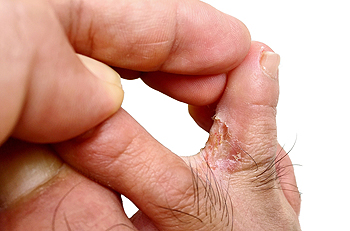
Athlete's foot, a common fungal infection, underscores the significance of daily foot hygiene in preserving overall health. This condition thrives in warm, moist environments, making it imperative for individuals, especially athletes, to prioritize cleanliness. Regular washing and thorough drying of feet, paying particular attention to spaces between toes, can deter the growth of fungi. Choosing moisture-wicking socks and breathable footwear is essential to minimize the conditions favorable for the infection. Sharing personal items, such as towels or shoes, should be avoided to prevent the spread of the fungus. Maintaining clean, dry feet not only aids in preventing athlete's foot but also promotes the general well-being of the feet. Vigilance in hygiene practices, coupled with prompt treatment if symptoms arise, empowers individuals to protect their feet from the discomfort and inconvenience associated with athlete's foot infection. If you have developed athlete’s foot, it is strongly suggested that you are under the care of a podiatrist to discuss effective treatment methods, which may include prescribed medication.
Athlete’s Foot
Athlete’s foot is often an uncomfortable condition to experience. Thankfully, podiatrists specialize in treating athlete’s foot and offer the best treatment options. If you have any questions about athlete’s foot, consult with Jim Maxka, DPM from South Penn Foot & Ankle Associates. Our doctor will assess your condition and provide you with quality treatment.
What Is Athlete’s Foot?
Tinea pedis, more commonly known as athlete’s foot, is a non-serious and common fungal infection of the foot. Athlete’s foot is contagious and can be contracted by touching someone who has it or infected surfaces. The most common places contaminated by it are public showers, locker rooms, and swimming pools. Once contracted, it grows on feet that are left inside moist, dark, and warm shoes and socks.
Prevention
The most effective ways to prevent athlete’s foot include:
- Thoroughly washing and drying feet
- Avoid going barefoot in locker rooms and public showers
- Using shower shoes in public showers
- Wearing socks that allow the feet to breathe
- Changing socks and shoes frequently if you sweat a lot
Symptoms
Athlete’s foot initially occurs as a rash between the toes. However, if left undiagnosed, it can spread to the sides and bottom of the feet, toenails, and if touched by hand, the hands themselves. Symptoms include:
- Redness
- Burning
- Itching
- Scaly and peeling skin
Diagnosis and Treatment
Diagnosis is quick and easy. Skin samples will be taken and either viewed under a microscope or sent to a lab for testing. Sometimes, a podiatrist can diagnose it based on simply looking at it. Once confirmed, treatment options include oral and topical antifungal medications.
If you have any questions, please feel free to contact our office located in Hanover, PA . We offer the newest diagnostic and treatment technologies for all your foot care needs.
